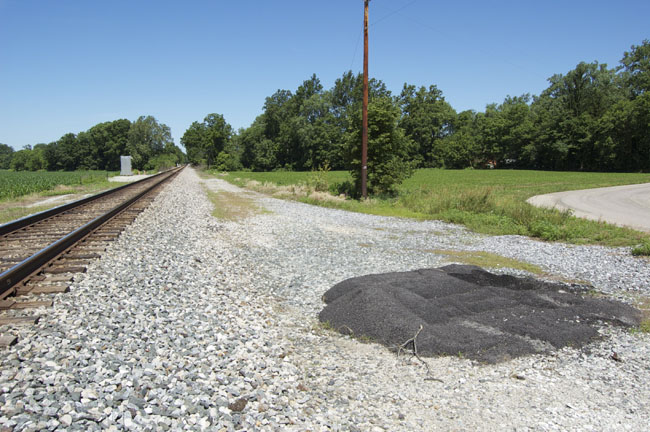 I like to use examples like this one because it’s the type of scene most of us would ignore totally. Nothing here but a field of grass right? Yes and no. This location is near a grade crossing, which is behind me. Clearly there is an access road for railroad maintenance vehicles to reach the relay box in the distance. It’s so simple yet how often do we model something like this? Furthermore, how many would include the clump of asphalt or whatever that is, that’s been dumped here?
I like to use examples like this one because it’s the type of scene most of us would ignore totally. Nothing here but a field of grass right? Yes and no. This location is near a grade crossing, which is behind me. Clearly there is an access road for railroad maintenance vehicles to reach the relay box in the distance. It’s so simple yet how often do we model something like this? Furthermore, how many would include the clump of asphalt or whatever that is, that’s been dumped here?
Is there any difference between the gravel ballast on the roadbed and that gravel in the drive? I think there might be. The reason I think this is because the gravel in the drive is getting compacted and worn down by vehicle traffic, however infrequently it might happen. This will produce a visual difference in the texture and coloring even if it’s a subtle one.
Let’s look at the utility pole. See the guy wire coming down on the left? What about the metal tag from the utility company about five or six feet up? Notice the plant growth? Wild vines and other growth will take full advantage of protected conditions and support, such as the base of a pole or building foundation. Look also at the taller weed growth near the edge of the access road. Indicates to me that the farmer didn’t want to risk damage to his equipment by getting too close to that gravel.
Notice further the patches of dead grass along the road edge. Something else easily overlooked. In the distance, notice how the relay box sits on a solid foundation of gravel that has been built up to track level. Again, it’s obvious when you see it, but something that’s easily overlooked at first.
Details like these lift model scenes from generic to life-like because everything rings true to the real 12″=1′ world. So, what do you see?
Regards,
Mike
Mike, this is another one of those scenes that more people should model, but don’t. Since I am viewing this on my iPhone, I didn’t see the tag on the pole until you mentioned it and the guy wires either. With close examination, I can see them. Other details that people generally forget are the conduits from the relay box into the ground. Most people are happy just to plop a model relay box down and be done with it, but what good is the box if it isn’t connected to anything?
The farmer might not be mowing up to the access road because of not wanting to damage his equipment, but probably it has more to do with the fact that it isn’t his land. The RR property probably extends to 3′ outside of the road and there is a possibility that there is a small ditch there as well. After all, the RR is all about drainage.
The pile of asphalt is probably what’s called “cold patch.” That is a particular type of asphalt formulated so that a crew can go out and fill potholes on a temporary basis and it remains malleable even when cold. It isn’t, however, permanent. It is also possible that a road crew out fixing potholes was finished for the day and dumped what was left in the small dump truck there at the edge of the access road, because, well, it’s just an access roar, right? Would I think to model that pile? I might, if I was following a photo, but probably not, I just wouldn’t think of it.
The above comment leads to a discussion of building roads. On the prototype, asphalt roads are laid in layers, normally two, but sometimes three. Whereas most of the time modelers slap down a piece of foam core, or matte board and are done with it for their roads. Well, what about the potholes? If we want realistic potholes, we really need to build the road like the prototype does, in layers of plaster or lightweight spackle. If we do that, then that gives us the ability to dig out potholes, and the spackle comes off in the layers leaving the one below, producing a much more realistic effect, but like many other things, it takes time to do it that way. Then again, if we want it to be done right and look prototypical, we need to take our time anyway.
Hi Jim,
Thanks for the comments and observations. They’re just what I was hoping this series would spark. It really is the “little things” like conduits, guy wires and potholes that set a scene apart.
As mentioned, there is a grade crossing directly behind me in this location. The asphalt could have also been leftover from a repair or other crossing maintenance. I’ll have to check the area again to see if that’s so.
You’re going to love the next two photos in the series. Number three goes up on 9/14 and number four the following week.
Regards,
Mike